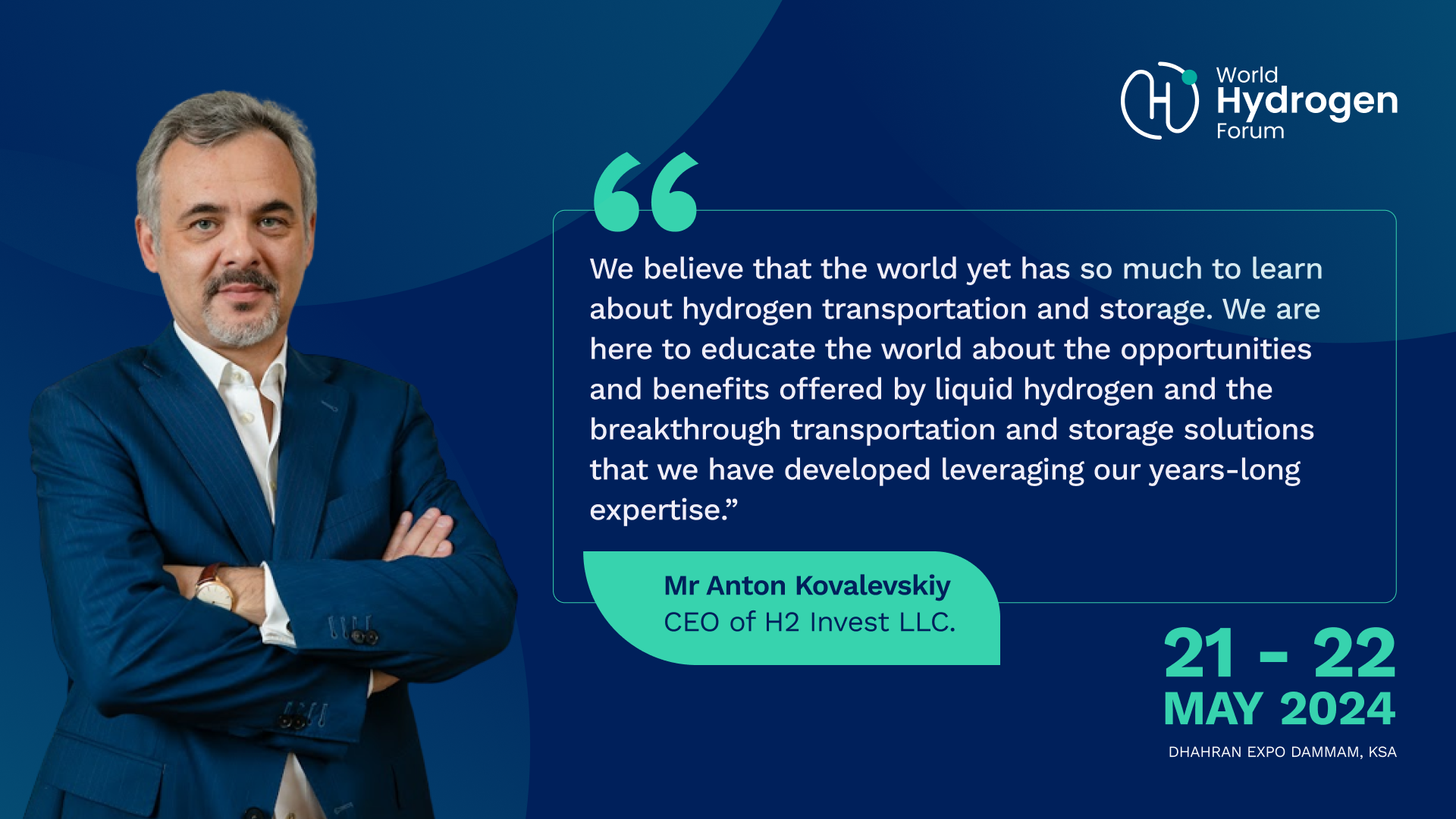We are delighted to present a Q&A Session with Mr Anton Kovalevskiy, the CEO of H2 Invest LLC, a leading figure in the burgeoning hydrogen industry. In this exclusive Q&A session, Mr Kovalevskiy delves into the transformative potential of hydrogen, particularly in its liquid form, for large-scale energy storage and transportation. With a wealth of experience and expertise in hydrogen and electrochemical assets, H2 Invest emerges as a pivotal player in advancing innovative solutions for the global energy landscape. Through insightful responses, Mr. Kovalevskiy elucidates the benefits, challenges, and future prospects of liquid hydrogen, shedding light on its pivotal role in shaping the energy transition. This discussion not only underscores H2 Invest's commitment to spearheading the hydrogen economy but also highlights the immense opportunities it presents for sustainable development on a global scale.
#WHF: Hydrogen can be stored in various ways, but what makes its liquid form uniquely powerful for large scale energy storage and transportation? Could it be a game-changer?
Anton Kovalevskiy: Comprehensive energy transition is unthinkable without heavy investments in infrastructure. Large-scale storage and transportation solutions are crucial for marketing hydrogen as a truly global commodity. To ship the projected volumes of hydrogen in the future, the market will clearly use ALL AVAILABLE transportation and storage solutions. But for the time being, we have to rely on the existing infrastructure and technologies to kick-start the hydrogen economy and to activate the supply chain. Transportation of pure hydrogen through pipelines is a prospect of the distant future, as such pipelines are very few now. Building new pipelines requires substantial capex and time resources, and that is why market players are currently considering shipping gas mixtures through existing gas pipelines. This is a temporary measure as long as we have no dedicated hydrogen infrastructure in place. Transportation of liquid organic hydrogen carriers (LOHC) is only theoretically possible as of today since the technology is not yet mature enough for a scale-up. In these conditions, liquid hydrogen and cryogenic transportation and storage solutions may take the centre stage. Liquid hydrogen offers a number of benefits, including high energy density, safety, and ready-made storage and transportation solutions. There are some global projects for constructing large hydrogen carriers, but they require purpose-built port infrastructure. We are advocating a more flexible approach instead. I am referring to standard-sized ISO tank containers designed for multimodal shipments, which can help remove nearly all geographic constraints for hydrogen transportation. I am reiterating that this technology is already available, and we are willing to share it with the world.
#WHF: What are the primary hurdles in storing liquid hydrogen, and what technological advancements are underway to improve efficiency and minimise boil-off?
Anton Kovalevskiy: In fact, liquid hydrogen storage solutions have been in use since the dawn of the space exploration era, which is why countries with advanced space programmes have developed extremely strong expertise in cryogenic technologies. The product we are introducing to the international market is a standard-sized 40 ft ISO tank container with a unique hydrogen holding time of over 30 days (that is to say more than 30 days WITHOUT boil-off!). Storage periods longer than 30 days are also possible, but today 30 days is the ideal term from an economic perspective. Multimodal transport is another advantage of our technology, as its ISO compliance allows the tank container to be carried by road, rail, and sea. You fill the container at the hydrogen production site and transport it directly to the end user. Our unique patented technologies significantly reduce opex and the price of such a container, making the cost of transporting 1 kg of hydrogen very competitive.
#WHF: How do we safely move vast quantities of liquid hydrogen from point A to point B? What are the current transportation methods and the critical safety measures in place?
Anton Kovalevskiy: Hydrogen is classified as a hazardous material, but our tank container fully complies with the International Maritime Dangerous Goods (IMDG) Code. Our production processes are certified, with each stage supervised by a dedicated certifying authority. It is now clear that the issue of hydrogen's explosiveness is more of a myth or a phobia. There are several studies proving, for example, the identical safety of liquid hydrogen and liquid natural gas. Hydrogen is the lightest of all gases, so in the event of a leak, it instantly evaporates and disperses. The vapours of leaked LNG, on the other hand, linger on the ground and remain explosive for some time. From an environmental standpoint, leaked pure hydrogen is completely harmless compared to, let’s say, ammonia. It is no secret that large volumes of ammonia can produce vastly detrimental effects. Speaking of ammonia as a vehicle for transporting hydrogen, it stands to note that ammonia cracking releases extremely harmful nitrogen dioxide into the air, which brings into question the alleged environmental friendliness of this hydrogen-containing mixture. Needless to say, ammonia was, is and will be a highly valued compound for agriculture and other traditional application purposes, but this is a different story and it has nothing to do with hydrogen energy.
#WHF: As an exhibitor at the World Hydrogen Forum, what are your primary goals for participation, and how do you envision this event contributing to their achievement?
Anton Kovalevskiy: We believe that the world yet has so much to learn about hydrogen transportation and storage. We are here to educate the world about the opportunities and benefits offered by liquid hydrogen and the breakthrough transportation and storage solutions that we have developed leveraging our years-long expertise. We are happy that not only does Saudi Arabia believe in hydrogen, but also backs its commitment up with actions just like we do. We are positive that Saudi Arabia has every chance to lead the global hydrogen movement, whereas we can help it with our state-of-the-art solutions.

